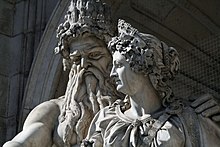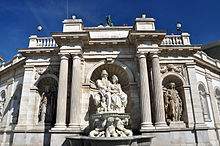Albrechtsbrunnen (Vienna)
The Albrechtsbrunnen , also known as Danubiusbrunnen, is a fountain in Vienna's 1st district , the inner city . It is located at the Augustinerbastei and bears its name after Field Marshal Archduke Albrecht von Österreich-Teschen , who lived in the building of today's Albertina (see Albertinaplatz ) on the bastion, the Archduke Albrecht's palace at that time.
location
The fountain was built by the Wiener Stadterweiterungsfonds , a state fund that made money through the sale of building sites in the course of the city expansion that began in 1857 and was used to finance prestigious buildings. It was built behind the Hofoper (now the State Opera) , construction of which began in 1861. This is where the Augustinian Bastion of the former Vienna city wall is located , on which (as the wing of the Hofburg ) the Archduke Albrecht Palace is enthroned, the location of today's Albertina .
Depicted rivers
In addition to the allegorical representation of the relationship between the city of Vienna (Vindobona) and the Danube river (Danubius), the rivers Inn (sculpture today in the Burggarten), Save , Drau (sculpture today in the Burggarten), Tisza , Mur , Salzach , March , Raab , Enns and Traun to showcase the power and size of Austria-Hungary .
history
The construction of the fountain at today's street level, so to speak under the bastion, began on July 24th, 1864, the unveiling took place on December 24th, 1869; The Court Opera had started operating in its new house seven months earlier. On the occasion of the unveiling of the fountain, the fountain figures were given to the City of Vienna.
The Palais Archduke Albrecht became state property on the basis of the Habsburg law in 1919, and the court opera became the state opera. The fountain was badly damaged in a bombing raid on Vienna on March 12, 1945. The restoration after the Second World War took place in a greatly reduced form; the originally drivable ramp from Augustinerstraße to the bastion was shortened to a staircase. Only Danubius and Vindobona , the main characters, and the allegories of Save and Tisza remained at the location of the fountain . With a municipal council resolution of October 25, 1952, these were given to the federal government in order to get the maintenance costs from the municipal budget.
The allegorical depictions of the rivers Enns , Mur , Raab , Salzach and Traun came to the palace gardens of Wieselburg an der Erlauf (Lower Austria), the Drau came to Greifenburg an der Drau (Carinthia) and the Inn to Wiener Neustadt (Lower Austria). The March is missing. The wall niches in which they were erected were bricked up.
In order to be able to restore the Albrechtsbrunnen, the City of Vienna endeavored to return the figures scattered in the country, which was also achieved in 1985 and 2001/2002. The missing March figure has been replaced by a copy. In the course of the redesign of the entrance area of the Albertina, the Inn had to give way to an escalator around the year 2000 , and in order to preserve the symmetry of the fountain system, the Drava on Hanuschgasse was also removed from its location. Both figures are now in the neighboring castle garden next to the butterfly house .
architecture
The architecture of the Albrechtsbrunnen, built as a wall fountain, was designed by Moritz von Löhr , the allegories were created by Johann Meixner from white Carrara marble . The fountain basin itself was made of Mauthausen granite ( Upper Austria ). The fluted double columns on both sides of the main fountain are made from the chalk limestone from Aviano near Pordenone in Italy, at the time of construction was still in the Austrian crown land of Veneto . The ramp's balustrade is made of Untersberg marble (Kronland Salzburg ), the base and cover plates are made of Zeindler stone, a hard imperial stone from Kaisersteinbruch (then Hungary, now Burgenland ).
The depiction of Danubius and Vindobona symbolizes the tense relationship between the river and the city - the wild expression of Danubius is reminiscent of floods and ice rushes that plagued the city again and again, but Danubius' hand on Vindobona's shoulder also shows his good sides .
See also
Individual evidence
- ↑ Robert Seemann , Herbert Summesberger: Wiener stone walking paths, the geology of the big city . Danubiusbrunnen p. 119, Verlag Christian Brandstätter, 1999 ISBN 3-85447-787-2
literature
- Felix Czeike : Historical Lexicon Vienna. Volume 1: A – Da. Kremayr & Scheriau, Vienna 1992, ISBN 3-218-00543-4 .
Web links
- The Albrechtsbrunnen - history and pictures
- Entry about Albertina (Archduke Albrecht Palace) on Burgen-Austria , history of the Albertina and the Albrechtsbrunnen
Coordinates: 48 ° 12 '15.15 " N , 16 ° 22' 6.59" E




